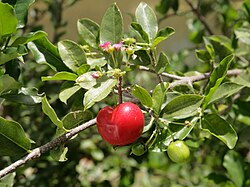| Wild Crapemyrtle | |
|---|---|
 | |
| Scientific classification | |
| Kingdom: | Plantae |
| Clade: | Tracheophytes |
| Clade: | Angiosperms |
| Clade: | Eudicots |
| Clade: | Rosids |
| Order: | Malpighiales |
| Family: | Malpighiaceae |
| Genus: | Malpighia |
| Species: | M. glabra |
| Binomial name | |
| Malpighia glabra | |
| Synonyms [1] | |
| |
Malpighia glabra, the wild crapemyrtle, is a tropical fruit-bearing shrub or small tree in the family Malpighiaceae. It has often been confused with the related cultivated crop tree M. emarginata , but has small insipid fruit and a very different flower structure. [2]